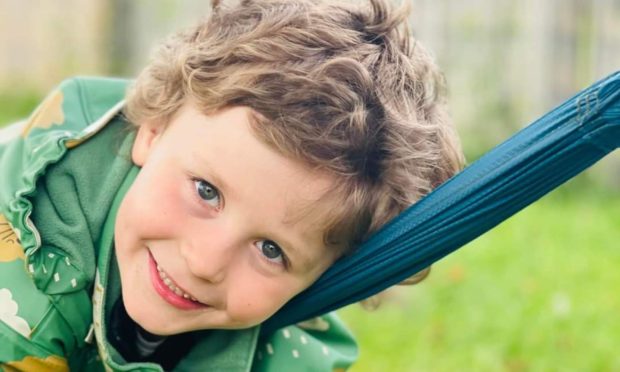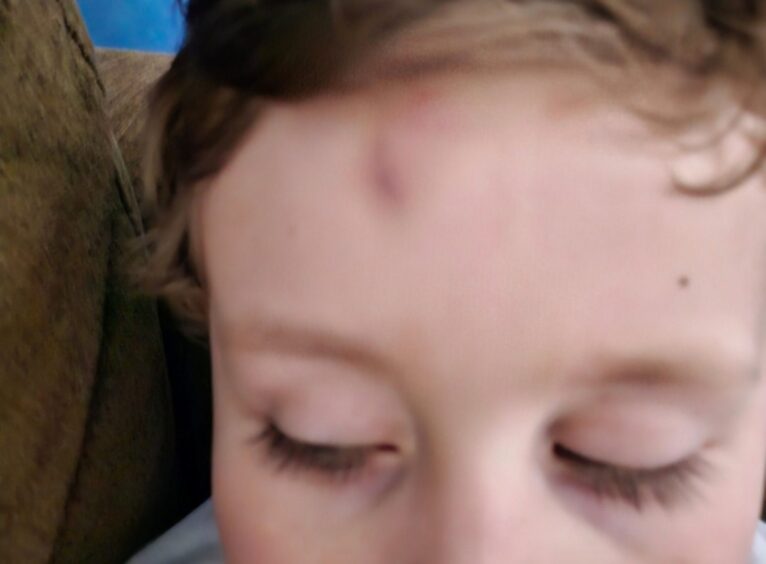
School staff watched from behind a closed door while a severely disabled child with the developmental age of a one-year-old banged his head off a wall in distress.
The school, Cairneyhill Primary near Dunfermline, then failed to inform Isaac Tocher’s parents that the seven-year-old, who has a brain disorder and autism, had injured his head, telling them instead that he was just upset.
When his distraught mum Vicki saw the bruises on his head, she immediately removed Isaac from Cairneyhill for his own safety.
She said: “I received a phone call from the school saying Isaac was upset.
“But they failed to mention he’d suffered a head injury because he’d been held alone in a room for so long he’d started banging his head off a wall in distress.
“When I saw the bruises, I couldn’t believe any school could think it was acceptable to return a little boy home in a state like that and not even mention it. If I had delivered my boy to school with unexplained bruising to his head, they would have sent social workers and the police to my door.
“Because Isaac has a brain disorder and can’t speak, he must be one of the most vulnerable children in Scotland.
“But I had to fight tooth and nail to find out exactly what happened to my boy.”
‘I can’t bear to think what else the school failed to tell me’
Vicki had to submit a subject access application to Fife Council before receiving all the documentation regarding the June incident.
She said: “What I discovered left me fearing for the safety of every vulnerable child in Scotland because there are no official policies or protocols to ensure they are protected, or that families are kept informed of incidents like this.”
Vicki, a pharmaceutical dispenser, also discovered an NHS nurse, who is part of Isaac’s care team, had already raised concerns with social workers and the community learning disability team over a series of failures in how Cairneyhill handled the incident.
This included failure to inform the care team, failure to use de-escalation techniques when Isaac was upset and keeping him a room with a closed door when the “distressed” little boy was unable to process their verbal instructions.
In her official report, she stated Cairneyhill staff were outside the closed door “observing Isaac from there”, he was “banging his head off wall.”
She reported they had “kept the door closed on Isaac when he tried to come out” and when she went into the room for 15 minutes to comfort the child, they “offered her arm guards”, they “didn’t come to check on her”. She reported “de-escalation strategies were not being used”.
Isaac, who also has learning difficulties and ADHD, has hyper mobility and requires a wheelchair at times.
His mother said: “What concerns me deeply is that the school treated Isaac as a seven-year-old child rather than a non-verbal child with disabilities and the developmental age of a 12 to 18-month-old toddler.”
Vicki, who has two other children, said Isaac was happy at Cairneyhill school for almost two years. She said: “His usual teacher went on sick leave. Since then, Isaac has repeatedly been sent home with bruises and marks on his face. He’s also been sent home in soaking wet, soiled nappies that have been on him for hours, despite me packing a change.
“Knowing what I know now, I can’t bear to think just what else the school failed to tell me about and what Isaac has been subjected to.”
Fife Council has admitted Cairneyhill failed to inform Isaac’s parents about his head injury.
Calum’s Law
Vicki is calling on all MSPs to support a new Bill being put forward by Labour MSP Daniel Johnson. Known as Calum’s Law, it will offer better protection to disabled children at school and ensure teachers have proper de-escalation training in place and end the use of restraint and isolation rooms.
She said: “I’m horrified Scotland doesn’t have legislation in place to properly protect children like Isaac, and that is why Calum’s Law is vital. I implore MSPs to support this Bill.”
Last week, Isaac had 18 teeth removed and he is awaiting an MRI scan to discover why he has been suffering headaches.
Vicki said: “He’s had all those teeth removed, but after learning what happened to my son at school, of course I worry whether the headaches have anything to do with that. We are still awaiting an answer.”
Campaigner Beth Morrison, who worked with Daniel Johnson to develop his Bill, named after her son Calum suffered restraint and abuse at school, said: “What happened to Isaac should never have happened to any child, never mind a profoundly disabled child with a developmental age of a one year old. I’m saddened to report that while this is a deeply shocking case, it is not an isolated one. That is why we desperately need Calum’s Law.”
Scottish Conservative Shadow Minister for Children and Young People Roz McCall, who is Vicki’s MSP, said: “I am utterly appalled by what happened to Isaac.
“We have a duty of care towards children in our care. If we have this automatic assumption about mainstreaming children, we must ensure that all schools have the specific training and resources to be able to do their job.”
Children’s rights
The Scottish Government incorporated the United Nations Convention of Rights of a Child (UNCRC) into Scots law.
But the UNCRC is clear that restraint and seclusion must only ever be used as a last resort to keep a child safe from harm. In a recent survey of over 200 parents whose children who had been restrained, 91% had autism or ADHD.
Johnson said: “Parents want to and have a right to know what happens to their children at school. If a child scrapes their knee in the playground, every parent is familiar with the little blue slip that comes home that night.
“What is difficult to understand is why there is push back when a similar approach is proposed for when injuries occur as a result of restraint and seclusion.
“That’s why my Bill will set out clear standards for statutory guidance on physical intervention, standardise and mandate training so de-escalation is at its heart and teachers are empowered to handle distressing incidents, and require reporting and recording, so parents stay informed, and the use of restraint and seclusion is monitored across local authorities.”
Fife Council’s head of education and children’s services, Angela Logue, said: “The safety and wellbeing of all pupils in our care is our first priority.
“At the time of the incident we were in direct contact with the family and carried out a full investigation into the concerns raised. Any appropriate actions were taken at that time. We continue to work with the family to meet the needs of the child in their new setting.”

Enjoy the convenience of having The Sunday Post delivered as a digital ePaper straight to your smartphone, tablet or computer.
Subscribe for only £5.49 a month and enjoy all the benefits of the printed paper as a digital replica.
Subscribe © Supplied
© Supplied © Supplied
© Supplied